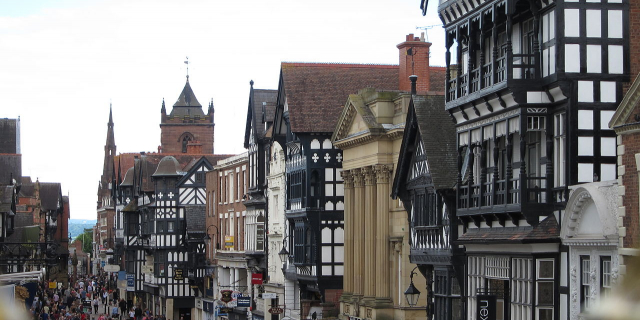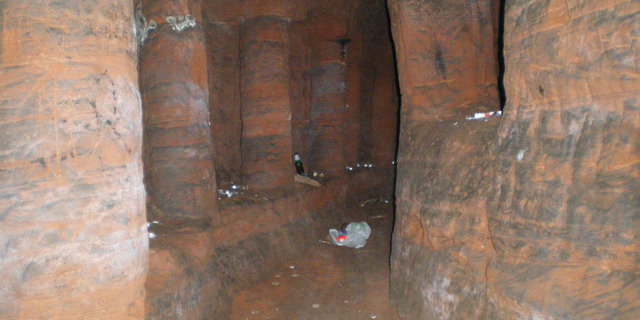Liverpool Metropolitan Cathedral
Liverpool Metropolitan Cathedral, officially known as the Metropolitan Cathedral of Christ the King and locally nicknamed "Paddy's Wigwam", is the seat of the Archbishop of Liverpool and the mother church of the Roman Catholic Archdiocese of Liverpool in Liverpool, England. The Grade II* Metropolitan Cathedral is one of Liverpool's many listed buildings.
The cathedral's architect, Frederick Gibberd, was the winner of a worldwide design competition. Construction began in 1962 and was completed in 1967. Earlier designs for a cathedral were proposed in 1933 and 1953, but neither was completed.
During the Great Irish Famine (1845–1852) the Catholic population of Liverpool increased dramatically. About half a million Irish, who were predominantly Catholic, fled to England to escape the famine; many embarked from Liverpool to travel to North America while others remained in the city.[1] Because of the increase in the Catholic population, the co-adjutor Bishop of Liverpool, Alexander Goss (1814–1872), saw the need for a cathedral. The location he chose was the grounds of St. Edward's College on St. Domingo Road, Everton.[2]
In 1853 Goss, then bishop, awarded the commission for the building of the new cathedral to Edward Welby Pugin (1833–1875).[3] By 1856 the Lady chapel of the new cathedral had been completed. Due to financial resources being diverted to the education of Catholic children, work on the building ceased at this point and the Lady chapel – now named Our Lady Immaculate – served as parish church to the local Catholic population until its demolition in the 1980s.[4]
Lutyens' design Illustration by Cyril Farey of Edwin Lutyens' unrealized design for the cathedral
Illustration by Cyril Farey of Edwin Lutyens' unrealized design for the cathedralFollowing the purchase of the 9-acre (36,000 m2) former Brownlow Hill workhouse site in 1930,[2] Sir Edwin Lutyens (1869–1944) was commissioned to provide a design which would be an appropriate response to the Giles Gilbert Scott-designed Neo-gothic Anglican cathedral then partially complete further along Hope Street.[5]
Lutyens' design was intended to create a massive structure that would have become the second-largest church in the world. It would have had the world's largest dome, with a diameter of 168 feet (51 m) compared to the 137.7 feet (42.0 m) diameter on St. Peter's Basilica in Vatican City.[6] Building work based on Lutyens' design began on Whit Monday, 5 June 1933,[6] being paid for mostly by the contributions of working class Catholics of the burgeoning industrial port.[7] In 1941, the restrictions of World War II wartime and a rising cost from £3 million to £27 million[8] (£1.42 billion in 2021),[9] forced construction to stop. In 1956, work recommenced on the crypt, which was finished in 1958. Thereafter, Lutyens' design for the cathedral was considered too costly and was abandoned with only the crypt complete.[6] The restored architectural model of the Lutyens cathedral is on display at the Museum of Liverpool.[10]
Scott's reduced designAfter the ambitious design by Lutyens fell through, Adrian Gilbert Scott, brother of Sir Giles Gilbert Scott (architect of the Anglican Cathedral), was commissioned in 1953 to work on a smaller cathedral design with a £4 million budget (£119 million in 2021).[9] He proposed a scaled-down version of Lutyens' building, retaining the massive dome. Scott's plans were criticised and the building did not go ahead.[2]
Gibberd's designThe present Cathedral was designed by Sir Frederick Gibberd (1908–84). Construction began in October 1962 and less than five years later, on the Feast of Pentecost 14 May 1967, the completed cathedral was consecrated.[2] Soon after its opening, it began to exhibit architectural flaws. This led the cathedral authorities to sue Frederick Gibberd for £1.3 million on five counts, the two most serious being leaks in the aluminium roof covering and defects in the mosaic tiles, which had begun to come away from the concrete ribs.[11] The design has been described by Stephen Bayley as "a thin and brittle take on an Oscar Niemeyer original in Brasilia,"[12] though Nikolaus Pevsner notes that the resemblance is only superficial.[13]








































Add new comment